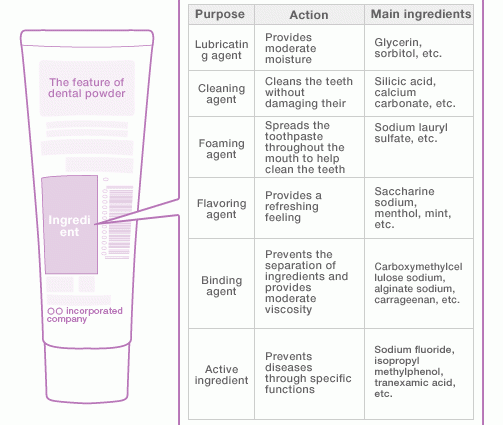Contents
For many years, brushing your teeth has been a duty of hygiene and a social requirement. None of us can imagine leaving the house without brushed teeth. Toothpaste is therefore one of the basic hygiene products. But what exactly does it have in its composition? And how to choose the right one?
1. Abrasives (abrasives, commonly called cleaning and polishing agents).
One of the main tasks of toothpaste is the most effective mechanical removal of dirt and plaque. In order to get rid of discoloration, you need an abrasive containing tiny grains. The property of modern abrasives is the ability to effectively wipe off dirt on the teeth while maintaining maximum enamel protection.
Currently used cleaning substances are, among others: hydrated silica (derived from sand), hydrated alumina, calcium carbonate and dicalcium phosphates. None of these materials would work on our teeth if it were not for mechanical cleaning with toothbrushes and mechanical removal of plaque
2. Foaming agents (detergents, i.e. surfactants or surfactants)
Your toothpaste is foaming because it contains special cleaning substances called detergents. The word detergent may have bad associations (e.g. with strong washing powders), and it is a name used to describe the mechanism of action of these substances. Detergents loosen the bonds in the molecules that settle on our teeth and make them dissolve in water. Thanks to this, it becomes possible to remove them from the surface of our teeth. In addition, they make the foam created during brushing, help to effectively remove the plate from hard-to-reach places.
The most commonly used detergent in toothpaste is sodium lauryl sulfate. People prone to mouth ulcers should be careful when using toothpastes with this particular detergent, as this ingredient may exacerbate irritation.
3. Fluorine compounds
Fluoride compounds are one of the most valuable ingredients in toothpaste. Fluoride has a very important function: it strengthens tooth enamel and makes teeth more resistant to decay. Fluoride compounds are built into the structure of our teeth. If the enamel surface of our teeth is frequently exposed to acids or microbial flora, small cavities may form on the surface, which are supplemented by fluoride from the toothpaste – a process called remineralization. What’s more, regular and frequent use of fluoride toothpaste additionally makes the teeth stronger and more resistant to repeated acid attacks.
In toothpastes we find fluoride in the form of sodium fluoride, potassium fluoride, tin fluoride or organic fluorides, i.e. fluoroamines.
4. Gelling agents (emulsifiers, stabilizers, viscosity regulators)
Gelling agents are a combination of ingredients that allow you to maintain the appropriate water content in the paste and at the same time bind all the ingredients together (thanks to this, the ingredients do not break down and clump together). If the paste didn’t have these ingredients, it would look like paint and be completely dry.
Here are some common components of moisture retention systems:
– viscosity regulators: glycerol, propylene glycol and sorbitol;
– stabilizers: carrageenans (guar gum), acacia gum (acacia gum), sodium carboxymethylcellulose and magnesium aluminum silicate;
– preservatives: sodium benzoate, methylparaben, ethylparaben.
5. Flavoring and fragrances
Toothpaste would taste terrible without the addition of flavorings. That is why all toothpastes contain various flavors – both natural and artificial. Unfortunately, it is this group of substances that most often causes allergic reactions to toothpaste. On the other hand, the pleasant taste of the toothpaste makes us brush more eagerly.
Choosing the right paste
When choosing the right toothpaste, it is worth paying attention to toothpastes intended for specific purposes and specific ailments. They contain additional active substances that help to maintain, for example, white teeth, healthy gums or reduce the pain of sensitive teeth. Regardless of the sometimes miraculous composition of a toothpaste, most of them are always very effective, provided that you brush your teeth and tongue regularly (at least twice a day) and properly (minimum 2 minutes and the right technique).
1. Whitening toothpastes
Tooth whitening toothpastes usually do not contain any additional whitening ingredients apart from standard abrasives, but in much larger amounts and with a larger diameter of cleaning grains, they are more aggressive to the enamel. Therefore, some of them cannot be used every day.
2. Pastes to prevent plaque and calculus
The pastes, which are supposed to protect us from excessive plaque and tartar formation, contain mainly zinc citrate, zinc chloride and potassium pyrophosphate. Additionally, some toothpastes contain a chemotherapeutic agent called triclosan, which eliminates bacteria on the surface of our teeth. The combination of these ingredients creates an effective formula that protects us against periodontal diseases.
3. Pastes for hypersensitive teeth
There are several reasons for tooth sensitivity: exposed dentinal tubules, a weak, walled enamel layer, or exposed cervical areas of the teeth. Then, toothpastes that contain ingredients that block the transmission of pain impulses, including potassium nitrate and strontium chloride, can be effective. These toothpastes, however, do not reduce pain immediately and must be used for several weeks to be effective. Another effective and immediate solution is the use of pastes containing arginine with calcium carbonate, which work immediately after rubbing into the sensitive tooth.
What about mouthwashes?
You can buy mouthwashes on the market. The premise of fluids is the elimination of bacteria from the oral cavity, i.e. an antiseptic effect. In addition, the lotions have many other functions, similar to toothpastes, including anti-plaque and limescale and whitening. You use lotions after brushing your teeth and rinsing your mouth, as an adjunct to hygiene, not as a substitute for brushing your teeth.










